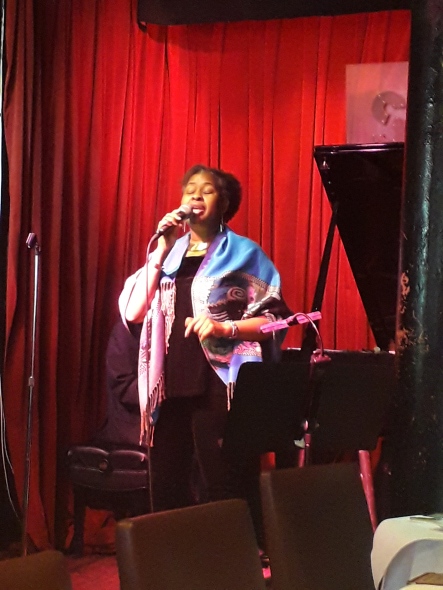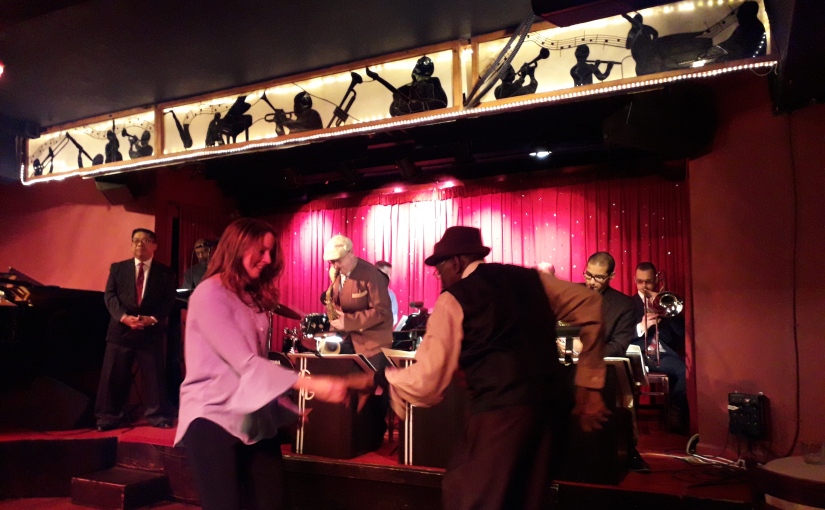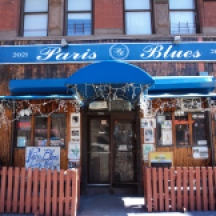A month in New York seems like years in other places. When I wasn’t in the library I was getting in as much live music and dance as I could: swing, jazz and blues. I heard some fantastic artists, saw some great tapping and enjoyed the dances, but my personal favourite in Harlem was American Legion Post 398 (thanks to Greg Izor for the recommendation). This venue belongs to the American Legion (a veterans association) located on 248 W 132nd St in the heart of Harlem and has become the home of jazz thanks to organist Seleno Clarke, who started the Sunday jam tradition. Seleno passed away in December, but the spirit of jazz continues, and every Thursday and Sunday there is a jam session led by saxophonist David Lee Jones and other resident musicians, with the best local talent and musicians from all over the globe joining in. The atmosphere is very welcoming with an audience that combines veteran regulars and music-loving tourists. Russell, Barbara and Karen behind the bar, made me feel at home watching the Oscars gala with them during the band breaks. The music is fantastic and on any given night you can find some well-known Harlem artists such as Anette St John, a singer who also performs at the Cotton Club and Smoke, among others. There is no cover charge (just a bucket collection for the band) and, a rare phenomenon in New York, –it’s possible to have a beer and a decent meal at a reasonable price. I cannot think of a better place to spend a Sunday evening and enjoy the jazz.
The Cotton Club, a mythical name for any jazz or swing fan, has inspired countless songs and films. Despite being a nightclub that only admitted white patrons and perpetuated a segregated society, performing there meant attaining the top in show business for African American artists of the twenties and thirties (among others Duke Ellington or Cab Calloway). The club was located initially on 142nd St with Lenox Avenue, later it moved downtown to 48th St and its latest incarnation is on 125th St. Those seeking the legendary Cotton Club of the twenties should be warned that the current venue somewhat lacks the glamour, although it keeps alive the musical and dance show tradition that made it famous. It was an unmissable rendez-vous, so I headed there on a cold Monday in March. Attendance was low, mostly tourists, but the quality of the musicians and dancers was well worth the 25 dollar cover charge. An excellent big band was swinging with singer Anette St John. I loved the chorus girl numbers with their sparkly jazz dance and the incredible tap dancers. Some of the band numbers were danceable, but I wouldn’t recommend it as an event for Lindy hoppers unless you were going with a partner or a group. The night I went there were few social dancers, although I was lucky to dance several songs with Ice, a charming gentleman who is a regular at all the swing dance events I attended in New York (he told me he only takes Wednesdays off). Here I also met Shana Weaver: chorus girl, Lindy hop dancer and Ambassador for the Frankie Manning Foundation, she continues the Cotton Club chorus line tradition that gave rise to great stars like Josephine Baker or Lena Horne.

Guitar prodigy King Solomon Hicks stands out among the club’s performers. I was lucky to see him playing again at Terra Blues, a highly recommended venue on Bleecker St. The 22 year-old achieves a moving blues sound and he easily wins the audience over with his technical virtuosity and charm. The Harlem guitar player started by playing in local neighbourhood jam sessions, where he earned his stripes with high quality musicians. He was still a teenager when he participated in the Apollo Amateur Night and was promptly hired by the Cotton Club. Nowadays, when he is not playing in the city he can be seen on tour around the US and Europe (last year he was in Spain playing in venues like the Jamboree club in Barcelona or Café Central in Madrid, as well as other festivals).

If you like your jazz with spectacular views the place is Jazz at Lincoln Center, a unique institution led by Wynton Marsalis, whose mission is to promote the enjoyment of jazz through performance and education “in the spirit of swing”. I have to love an organization that has a “Swing University”. Located at Columbus Circle (very close to Trump Tower, that’s New York for you), the venue’s window façade overlooking the city and Central Park alone is worth a visit. Jazz at Lincoln offers a high-quality varied music programme, ranging from its in-house orchestra led by Marsalis in person to the late night performances at Dizzy’s Coca Cola Club. Those who cannot attend live performances (either due to location or budget) can enjoy these concerts in live-streaming. In addition, Jazz at Lincoln provides an excellent education programme. I was very fortunate to attend a Listening Party about the International Sweethearts of Rhythm, an integrated all-woman big band of the 1930s and 1940s. Kit McClure’s orchestra, comprising ten women musicians, played versions from the repertoire of the International Sweethearts of Rhythm as well as showing some original footage. It was a double discovery: of the fascinating history of these pioneering women in swing, and of Kit McClure’s band, who offered a really swinging interpretation of great classics like “Jump Children”, “Vi Vigor” or “How About that Jive?”. More about New York: in a city where a coffee can cost five dollars I was able to enjoy the best swing music for free.

Not all jazz plans need be nocturnal, and a musical Sunday can start with a delicious jazz breakfast at Smoke (in this case featuring a trio and vocalist). This well-known Upper West “jazz and supper club” offers quality music in an intimate and cozy setting. The brunch menu is not cheap, but a jazz fan has got to keep her strength up in a city like this.

Swing 46 is a classic of the New York swing scene (located on 46th St). With live music seven days a week, Swing 46 was a favourite spot among dance legends like Dawn Hampton (several photos honouring her decorate a corner table where she used to sit). Tuesdays is the night of the George Gee Swing Orchestra, a band that has been playing for dancers for over thirty years, and their swing did not disappoint. Given the quality of this band and the discount price for dancers of only 10 dollars, I was surprised at the small number of dancers in attendance: barely a handful of couples and some inexperienced tourists (the weather might have been a factor: I learned the meaning of a Nor’Eastern during my stay). Luckily tireless Ice was there, always smiling and ready to cut a rug, with whom I danced some fun numbers — although I found it hard to keep up with this swing veteran.

A note to Dancers: the most buzzing dance night I found was the Frim Fram, which takes place every Thursday at a dance school (Club 412 on 8th Avenue). There is no live music but it is a meeting point for dancers from all over New York (and beyond) of all ages and levels. The atmosphere is relaxed and I danced non-stop: in summary, a night to dance your feet off and meet other local Lindy hoppers.
There is very little of Swing Era Harlem still standing, which is why the Apollo Theater on 125th deserves a special mention. With the Savoy and other major Harlem venues razed to the ground, the Apollo Theater is the only theatre that is still functioning, and very successfully, since 1934. That year Amateur Night at the Apollo started, the forerunner of the Got Talents and X-Factors of today, to which we owe the discovery of Ella Fitzgerald, Lauryn Hill or dancer Norma Miller, who also started her career winning a dance competition on this stage when she was only fourteen.
The list of stars who have performed at the Apollo is too long to detail, from James Brown to Michael Jackson, and a few years ago a “Walk of Fame” was installed on the sidewalk outside reflecting the premier place of this theatre in American culture. Many things have changed, but Amateur Night is still held every Wednesday (with a 10,000 dollar prize for the season winner). It is advertised as “The best fun you can have in this town for under $30”, and I can vouch this comedy and talent show makes good on its promise. Unlike other similar competitions, the audience not only chooses the winner by applause, but also has the power to boo-off performers: at which point a siren goes off and the famous “executioner” sweeps them off stage with his broom and dance. In this interactive show the audience is as much the protagonist as the contestants, of which there were all sorts: singers, dancers, rappers, poets…The Harlem crowd is not easy to please: if it does not like something it makes it known immediately and loudly.The night I attended they booed off the first three hopefuls as soon as they opened their mouths, which really makes me admire the bravery of the contestants who followed these acts on stage. Without question the best fun in Harlem.

My last week in New York I enjoyed dinner and a gig at Silvana’s Café, on 116th St in Harlem, thanks to my friend Loli Barbazán who now lives in the Big Apple. Less soaked in history, with a younger crowd and a friendly and multicultural vibe, Silvana’s brings together in its café cultural activities, good food and music. I was very pleasantly surprised by the different groups that played that night, anything from jazz to hip hop, and I especially fell in love with the tap dancers who went up to jam on-stage with the musicians. I wouldn’t mind going back.

I couldn’t leave without visiting Paris Blues, the well-known Harlem bar that was located round the corner from my apartment (also recommended by writer and occasional New Yorker Elvira Lindo). I wanted to spend my last hours soaking up all the neighbourhood music and charm that I could. The bar has been proudly run by Samuel Hargress, Jr. since 1968 and it remains true to its spirit: here you can find live jazz and blues every night until 3am for the price of a beer. The house band plays in a jam where other musicians join in, both young and old (a father with his teenage son for example). The warm atmosphere of this small bar encourages friendly conversation. There are few places like this left and it is worth enjoying them, even if it is just one for the road.

I read today that: “After all New York is a fiction, a literary genre that adapts to the traveller’s state of mind.” (Manuel Vicent, El País,19 August 2018), although in this case I experienced the city as a song or an album that accompanied me throughout all my wanderings (and in New York you can wander a lot, walking, on the train…). I haven’t tired of the songs at any time and I hope to return soon, although I know that a city like New York cannot repeat itself, with its constant rhythm and improvisation it never plays the same tune twice.
I want to thank the Frankie Manning Foundation for having given me the opportunity to stay in New York in order to carry out my research on the history of Lindy hop (which I will talk about in another post).











